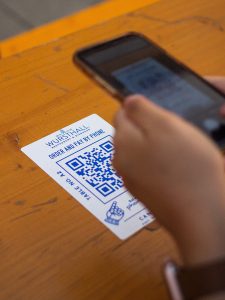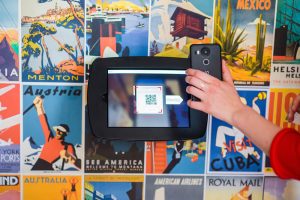The curious case of the QR code

In the ever-shifting landscape of popular culture, music often sees the meteoric rise of one-hit wonders—those fleeting moments when a particular song blares from car radios and dance floors, only to fade into obscurity shortly after. I, for one, proudly owned CDs by the likes of Eagle Eye Cherry and Duncan Sheik during their heydays, yet today, those discs would likely languish unsold, a forgotten snapshot of musical trends. Much like these transient hits, technology and marketing are also subjects to the ebbs and flows of trends. Take, for instance, the curious case of the QR code—entering the scene with a buzz, only to seemingly vanish in the blink of an eye.
The Fall of QR Codes
 In the dawn of the smartphone era, QR codes proliferated at a remarkable pace. They were plastered on advertisements, packaging, and even business cards. It was as if these pixelated mosaics held the keys to an interactive realm that would transform the way we engaged with the world. Yet, in a twist of fate, their presence diminished almost as swiftly as it burgeoned. As screens grew more cluttered and users grew more skeptical, QR codes were relegated to the annals of tech history, labeled as a passing fad. But, as with any intricate plotline, their narrative wasn’t over—because as the new decade dawned, so did the resurgence of QR codes, and this time, they returned not as a mere novelty, but as a cornerstone of modern interaction, more popular and effective than ever before.
In the dawn of the smartphone era, QR codes proliferated at a remarkable pace. They were plastered on advertisements, packaging, and even business cards. It was as if these pixelated mosaics held the keys to an interactive realm that would transform the way we engaged with the world. Yet, in a twist of fate, their presence diminished almost as swiftly as it burgeoned. As screens grew more cluttered and users grew more skeptical, QR codes were relegated to the annals of tech history, labeled as a passing fad. But, as with any intricate plotline, their narrative wasn’t over—because as the new decade dawned, so did the resurgence of QR codes, and this time, they returned not as a mere novelty, but as a cornerstone of modern interaction, more popular and effective than ever before.
While they started off with a bang, the fading away of QR codes in the early 2010s can be attributed to a few key factors:
- Lack of User Understanding: When QR codes first gained popularity, many users didn’t fully understand what they were or how to use them. There was often a sense of uncertainty and confusion surrounding their purpose.
- Poor User Experience: Scanning QR codes required users to download specific apps, which added an extra step to the process. If the scanning experience wasn’t seamless or if the app was cumbersome to use, users might have been discouraged from engaging with QR codes.
- Limited Mobile Connectivity: In the early days of smartphones, mobile internet speeds were often slower and less reliable. This could result in frustrating experiences when attempting to scan QR codes and access online content.
These factors, combined with a general sense of novelty wearing off, contributed to the decline of QR code usage in the early 2010s. However, the subsequent advancements in smartphone technology, changes in user behavior, and the adaptation of QR codes for diverse applications have led to their resurgence and increased popularity in recent years.
So why are QR codes becoming popular again?
 So, the question remains, why are QR codes becoming popular again? There are countless reasons for why QR codes are experiencing renewed popularity for several reasons:
So, the question remains, why are QR codes becoming popular again? There are countless reasons for why QR codes are experiencing renewed popularity for several reasons:
- Contactless Interactions: The ongoing COVID-19 pandemic has accelerated the adoption of contactless technologies. QR codes allow users to access information, make payments, and perform other tasks without physical contact, making them an ideal solution in a touch-sensitive world.
- Built-in Smartphone Support: Most smartphones now come equipped with built-in QR code scanners as part of their default camera apps. This eliminates the need for users to download a separate QR code scanning app, making the process more seamless.
- Versatility: QR codes can be used for a wide range of applications, from product information and marketing campaigns to event check-ins and digital payments. This versatility makes them appealing to businesses and individuals looking for efficient ways to share information.
- Marketing and Advertising: Businesses are utilizing QR codes in their marketing strategies. Scanning a QR code can quickly direct users to a website, landing page, app download, or social media profile, making it a powerful tool for driving engagement and conversions.
- Easier Data Sharing: QR codes can store various types of data, including URLs, contact information, calendar events, and more. They simplify the process of sharing complex information by allowing users to scan and access the data directly.
- Enhanced User Experience: QR codes provide a convenient and interactive way for users to access content or services. For example, museums and tourist attractions use QR codes to offer additional information about exhibits or locations.
- Payment and Transactions: QR codes are being used for mobile payments in various parts of the world. They enable users to make payments by scanning a code displayed at a merchant’s point of sale, eliminating the need for physical cards or cash.
- Supply Chain and Tracking: QR codes are employed in supply chain management for tracking products and inventory. Consumers can scan QR codes on products to access information about their origin, ingredients, or authenticity.
- Easy Adoption: QR codes are simple to create and implement, requiring minimal investment. Businesses can easily generate QR codes for their products, services, or promotions without significant technical expertise.
- Interactive Print Media: QR codes can bridge the gap between print and digital media. Magazines, brochures, posters, and billboards can incorporate QR codes to offer readers or viewers additional content or information.
- Smart Packaging: QR codes are used on product packaging to provide customers with information about usage, maintenance, warranties, and recycling instructions.
The resurgence of QR codes is driven by their convenience, ease of use, and adaptability to various contexts. As more industries find innovative ways to leverage QR codes, their popularity is likely to continue growing.
What appears to be lost can often be re-imagined
 In an ever-shifting landscape, QR codes stand not only as a testament to resilience but as a beacon of innovation, reminding us that even in the most fleeting moments, there lies potential for reinvention. Much like the one-hit wonders that momentarily flood the airwaves, QR codes too experienced their meteoric rise, a sudden fade, and now a triumphant resurgence. Their journey from buzz to oblivion to their current prominence parallels the fleeting fame of those songs that once dominated the charts and then faded into obscurity. But unlike those forgotten tunes, QR codes have written a new verse—one of adaptability, relevance, and endurance.
In an ever-shifting landscape, QR codes stand not only as a testament to resilience but as a beacon of innovation, reminding us that even in the most fleeting moments, there lies potential for reinvention. Much like the one-hit wonders that momentarily flood the airwaves, QR codes too experienced their meteoric rise, a sudden fade, and now a triumphant resurgence. Their journey from buzz to oblivion to their current prominence parallels the fleeting fame of those songs that once dominated the charts and then faded into obscurity. But unlike those forgotten tunes, QR codes have written a new verse—one of adaptability, relevance, and endurance.
The QR code’s odyssey is a testament to the enduring power of adaptation, a digital footnote that speaks volumes about our capacity to reshape the narrative of technology, and in doing so, to rewrite the chapters of how we connect, engage, and experience the world around us. As we scan these pixelated gateways, we’re not just accessing information; we’re partaking in a narrative of transformation—a journey that mirrors the evolution of pop culture and technology alike. From the ephemeral success of a hit song to the persistent relevance of QR codes, both remind us that even in a world of rapid change, what appears to be lost can often be re-imagined, reintegrated, and revitalized.
